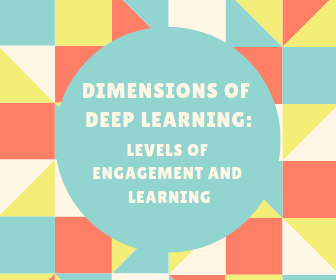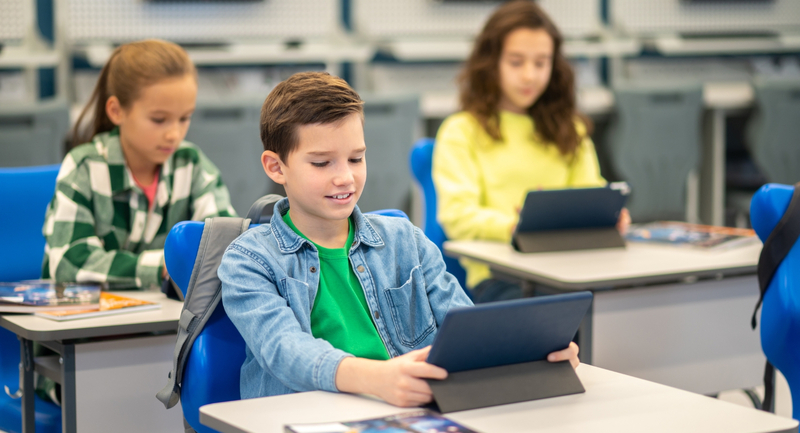This series of commentaries is built on the idea that the development of deep learning understanding, skills, and habits of mind are important for all students to develop in a 21st-century world. So far in this series, we have focused on defining and describing the characteristics of deep learning. In this third commentary, I focus on another very important question – what are the dimensions of deep learning instruction? I also attempt to distinguish between basic and deep learning, both of which are important in the deep learning process.
As stated earlier in this series, aside from a teacher’s commitment to providing deep learning educational experiences, three key aspects of deep learning are
- The teacher has a deep learning mindset. She makes a significant effort to go beyond basic understanding and skill development.
- Students are heavily engaged in the learning process. They are given greater opportunity to ask questions, construct meaning, and think more deeply with greater complexity.
- Instructional activities promote “high cognitive challenge”, such as analyzing data, constructing interpretations, developing carefully constructed points of view, and figuring out complex solutions to problems.
- Students are given opportunities to apply learning to authentic situations that build deep learning understanding and skills, develop curiosity and interest, promote critical habits of mind, and illustrate the value of the learning beyond school.
How does this happen? How do these aspects play out in the classroom? I propose that learning can be best measured by a focus on two distinct dimensions of instruction – levels of engagement and levels of learning. The highest level of learning – deep learning - is when students are both highly engaged in the learning process and are cognitively challenged at high levels. The lowest levels of learning usually are represented by minimal student engagement and low-level cognitive challenges (although it is also possible to have high levels of student activity and minimal cognitive challenges). These two aspects of learning are intertwined and are further described below.
Levels of Student Engagement
Three levels of student engagement are identified below – passive, mixed, and highly engaged.
At the lowest level, students are primarily not engaged in the learning process. Classrooms are almost exclusively teacher-centered. Students are usually passive or compliant. Practically, a teacher with passive student engagement usually lectures, asks closed-ended questions that elicit relatively simple responses, generally with only right or wrong answers, or assigns worksheet type activities requiring relatively simple responses.
Level two mixes teacher centeredness with some level of student centeredness. There are times when the classroom is highly teacher-centered, but also times when students are more engaged, through structured group activities, class discussions, activities such as the development of timelines or compare or contrast activities, and the like.
At level three, the highest level of engagement, teacher centeredness is rare. Students are fully and most frequently engaged in the learning process. Teachers act more like coaches and support independent-collaborative learning. Through visual organizers, research tasks, coaching, open-ended discussion questions, authentic projects and tasks, simulations and role plays, and other highly engaging activities, students are almost always actively engaged in the learning process.
Levels of Learning: From Below Basic to Deep Learning
Three levels of learning are identified below - Below Basic, Basic and Deep Learning
With below basic instruction, limited knowledge and skills are taught or learned. For example, my daughter, during her middle school years, was taught by English teachers whose primary goal was to teach grammar. There were minimal reading and writing opportunities, limited cognitive challenges, and few self-directed learning opportunities. Grammar exercises were repeated in every English class over three grade levels! Other examples include classes that consist primarily of simple worksheets, the teaching of fragmented knowledge where few connections are made, mostly rote learning and memorization, and the teaching of mathematical problem-solving algorithms without any underlying understanding. Another form of below basic learning consists of engaging activities that create limited learning opportunities. Building dioramas is fun for students but often has limited learning associated with it. A key clue to below basic instruction is that students often can’t state in their own words what they are learning, explain its importance, or connect their learning to previous knowledge and understanding.
Good basic instruction is important because it equips students with critical background knowledge and core skills. With good basic instruction, there is a strong focus on building student understanding and developing multiple types of core skills. For example, a teacher teaching the American Revolution may work with students to develop a timeline-sequence of events that enable students to explain why the Revolution occurred. There are opportunities for students to develop study and research skills, build patterns and sequences, form new concepts, learn new vocabulary, develop basic writing skills, and begin to develop analyses and interpretations. Culminating unit assessments include traditional multiple-choice, short answer, and matching question tests, but also include will include assessments such as graphic organizers, reflective essays, simple projects, and culminating presentations.
Deep learning instruction goes beyond basic instruction because it enables students to refine, enlarge and extend their understanding, develop advanced processes and skills, and apply learning to new, novel and authentic situations. Deep learning instruction fosters complex, high levels of cognitive challenge and development – i.e. it enables students to explain their reasoning, analyze complex data, build theories, create interpretations, and think creatively. Students deepen their understanding of key ideas, make new connections, build complex relationships, and apply what they are learning to challenging situations. Students learn to communicate their thinking, develop complex research skills, communicate their ideas, and develop self-directed learning skills.
Some examples of deep learning instruction are when, after basic learning has occurred, students are asked to:
- Continue to research and synthesize material from multiple sources
- Compare and contrast multiple aspects and dimensions
- Develop and test hypotheses
- Develop a theory from basic information
- Write a complex research paper
- Construct a real life solution to a challenging authentic problem
- Develop and argue for a position-point of view
- Explain the process used for arriving at a solution
- Explain a variety of alternative perspectives to the same event or theory
- Interpret a reading, literature
- Design and conduct an original experiment
- Analyze a complex document or data
- Determine complex, multiple lines of cause and effect
- Develop a new unique perspective
- Critique a source, such as a textbook, TV station, social media, etc.
- Create new ways to solve problems
- Use the creative problem-solving process to redefine and solve difficult problems
- Participate in a Socratic dialogue
- Participate in a debate
- Design and complete a culminating task
The Connections Between Levels of Engagement and Learning
These two aspects – levels of engagement and levels of learning - can be used to observe and analyze classrooms and schools to determine the quality of instruction. Chart one below illustrates how the quality of instruction can be analyzed using levels of engagement and learning. Educational leaders can use this chart to help teachers understand their levels of engagement and learning, and focus on increasing both student engagement and learning levels. As a teacher, you can determine your own levels of engagement and learning of your students and decide what you can do to begin the raise the levels of both. This is a good beginning system for focusing on a school or classroom level of learning.
How do we raise the levels of engagement and promote strong basic and deep learning in classrooms and schools? In our next commentary, we will examine an instructional planning and teaching model that incorporates four stages of instruction designed to improve the levels of student engagement and promote strong basic and deep learning.
This article is one part of a bi-weekly series primarily focused around basic and deep teaching and learning. There will also be occasional articles around other topics of interest to educators.








